fresco -
A method of painting on plaster,
either dry (dry fresco or fresco secco) or wet (wet or true fresco).
In the latter method, pigments
are applied to thin layers of wet plaster so that they will be
absorbed and the painting
becomes part of the wall.
Some examples:

Roman, ![]()

![]() Wall
in the House of Sallust, Pompeii, 3rd century BCE, fresco,
First Style (also called incrustation
or masonry style), in situ.
Wall
in the House of Sallust, Pompeii, 3rd century BCE, fresco,
First Style (also called incrustation
or masonry style), in situ.
A
reconstruction of how it may have originally looked and

Rome, Cubiculum (bedroom) from the Villa of P. Fannius
Synistor, c. 40-30 BCE,
Republican, Second Style (also called the architectonic
style), fresco; room: 8 feet 8 1/2 inches x 10 feet 11 1/2 inches
x 19 feet 7 1/8 inches (265.4 x 334 x 583.9 cm), Metropolitan
Museum of Art, NY. See cubiculum.
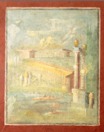
Roman, Landscape, c. 40 CE,
fresco "end of
Third Style", scene: 66.2-66.6 x 52.3-52.8 cm, white border:
2-7 mm, red wall: 7.7-15.5 cm, George Ortiz collection. Allegedly
from Stabiae. The trattegio in this fresco has been applied to
a very small area just below the pair of figures in the upper
third of the picture. Concerning its use here, Otiz's catalogue
entry states: "In the present case, the restorer has made
an exception to the rule by using both vertical and horizontal
brushstrokes." See landscape and tratteggio.

Rome, Polyphemus and Galatea in a landscape,
c. 31 BCE
- 50 CE,
mid-Augustan, Third Style (also called the ornamental
or ornate style), fresco,
height 73 3/4 inches (187.33
cm), Metropolitan Museum of Art, NY.

North Italian Painter, first quarter 14th
century, Two
Angels, fresco; (the one shown) 23 3/8 x 31 1/2 inches
(59.4 x 80 cm); (the second) 23 1/2 x 31 1/2 inches (59.7 x 80
cm), Metropolitan Museum of Art, NY. See angel.
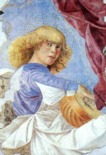
Melozzo Da Forli (Italian, 1438-1494), Music-Making Angel (Angel with a Lute),
fresco, c. 1480, Vatican, Italy. See angel and music.
![]()
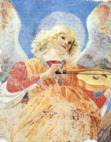
![]()
Melozzo Da Forli, Music-Making Angel (Angel with a Violin),
fresco, c. 1480, Vatican, Italy.
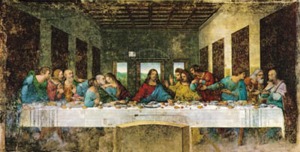
Leonardo da Vinci (Italian, 1452-1519), The
Last Supper, 1495-98, [180 k,] modified fresco,
15 x 29 feet (460 x 880 cm), Convent of Santa Maria delle Grazie
(Refectory), Milan. Leonardo devised an experimental medium which
employed some aspects of fresco, but was far from being true
fresco. The painting began to deteriorate even during Leonardo's
lifetime. The reasons for this disaster are more likely the result
of humidity in the wall than because of flaws in Leonardo's technique.
See cenacle, focal
point, Renaissance, and
symmetry.
Michelangelo Buonarroti (Italian, 1475-1564),
Signorelli, Girlandaio, 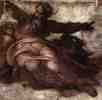 and
others in the Sistine Chapel, in Vatican City, Rome. Michelangelo
was commissioned by Pope Julius II della Rovere in 1508 to repaint
the ceiling, and completed these famous frescos between 1508
and 1512. Details of the ceiling: Creation of the Sun and Moon
and
others in the Sistine Chapel, in Vatican City, Rome. Michelangelo
was commissioned by Pope Julius II della Rovere in 1508 to repaint
the ceiling, and completed these famous frescos between 1508
and 1512. Details of the ceiling: Creation of the Sun and Moon , Delphic Sylph, Cummic Sybil , and The Creation of Adam. He later painted The
Last Judgement over the altar, between 1535 and 1541.
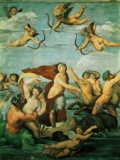
Raphael Sanzio (Italian, 1483-1520), The Nymph Galatea, c. 1512-14, fresco,
116 x 88 1/2 inches (295 x 225 cm), Villa Farnesina, Rome.
Also see art conservation, cartoon, incrustation, marbling, mural, quadro riportato, and sinopia.
https://inform.quest/_art
Copyright © 1996-![]()